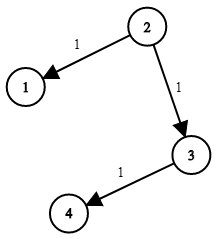有 n 个网络节点,标记为 1 到 n。
给你一个列表 times,表示信号经过 有向 边的传递时间。 times[i] = (ui, vi, wi),其中 ui 是源节点,vi 是目标节点, wi 是一个信号从源节点传递到目标节点的时间。
现在,从某个节点 K 发出一个信号。需要多久才能使所有节点都收到信号?如果不能使所有节点收到信号,返回 -1 。
示例 1:
输入:times = [[2,1,1],[2,3,1],[3,4,1]], n = 4, k = 2 输出:2
示例 2:
输入:times = [[1,2,1]], n = 2, k = 1 输出:1
示例 3:
输入:times = [[1,2,1]], n = 2, k = 2 输出:-1
提示:
1 <= k <= n <= 1001 <= times.length <= 6000times[i].length == 31 <= ui, vi <= nui != vi0 <= wi <= 100- 所有
(ui, vi)对都 互不相同(即,不含重复边)
方法一:朴素 Dijkstra 算法
class Solution:
def networkDelayTime(self, times: List[List[int]], n: int, k: int) -> int:
N = 110
INF = 0x3f3f
g = [[INF] * N for _ in range(N)]
for u, v, w in times:
g[u][v] = w
dist = [INF] * N
dist[k] = 0
vis = [False] * N
for i in range(n):
t = -1
for j in range(1, n + 1):
if not vis[j] and (t == -1 or dist[t] > dist[j]):
t = j
vis[t] = True
for j in range(1, n + 1):
dist[j] = min(dist[j], dist[t] + g[t][j])
ans = max(dist[1: n + 1])
return -1 if ans == INF else ansclass Solution {
private static final int N = 110;
private static final int INF = 0x3f3f;
public int networkDelayTime(int[][] times, int n, int k) {
int[][] g = new int[N][N];
for (int i = 0; i < N; ++i) {
Arrays.fill(g[i], INF);
}
for (int[] e : times) {
g[e[0]][e[1]] = e[2];
}
int[] dist = new int[N];
Arrays.fill(dist, INF);
dist[k] = 0;
boolean[] vis = new boolean[N];
for (int i = 0; i < n; ++i) {
int t = -1;
for (int j = 1; j <= n; ++j) {
if (!vis[j] && (t == -1 || dist[t] > dist[j])) {
t = j;
}
}
vis[t] = true;
for (int j = 1; j <= n; ++j) {
dist[j] = Math.min(dist[j], dist[t] + g[t][j]);
}
}
int ans = 0;
for (int i = 1; i <= n; ++i) {
ans = Math.max(ans, dist[i]);
}
return ans == INF ? -1 : ans;
}
}const Inf = 0x3f3f3f3f
type pair struct {
first int
second int
}
var _ heap.Interface = (*pairs)(nil)
type pairs []pair
func (a pairs) Len() int { return len(a) }
func (a pairs) Less(i int, j int) bool {
return a[i].first < a[j].first || a[i].first == a[j].first && a[i].second < a[j].second
}
func (a pairs) Swap(i int, j int) { a[i], a[j] = a[j], a[i] }
func (a *pairs) Push(x interface{}) { *a = append(*a, x.(pair)) }
func (a *pairs) Pop() interface{} { l := len(*a); t := (*a)[l-1]; *a = (*a)[:l-1]; return t }
func networkDelayTime(times [][]int, n int, k int) int {
graph := make([]pairs, n)
for _, time := range times {
from, to, time := time[0]-1, time[1]-1, time[2]
graph[from] = append(graph[from], pair{to, time})
}
dis := make([]int, n)
for i := range dis {
dis[i] = Inf
}
dis[k-1] = 0
vis := make([]bool, n)
h := make(pairs, 0)
heap.Push(&h, pair{0, k - 1})
for len(h) > 0 {
from := heap.Pop(&h).(pair).second
if vis[from] {
continue
}
vis[from] = true
for _, e := range graph[from] {
to, d := e.first, dis[from]+e.second
if d < dis[to] {
dis[to] = d
heap.Push(&h, pair{d, to})
}
}
}
ans := math.MinInt32
for _, d := range dis {
ans = max(ans, d)
}
if ans == Inf {
return -1
}
return ans
}
func max(x, y int) int {
if x > y {
return x
}
return y
}class Solution {
public:
int N = 110;
int INF = 0x3f3f;
int networkDelayTime(vector<vector<int>>& times, int n, int k) {
vector<vector<int>> g(N, vector<int>(N, INF));
for (auto& e : times) g[e[0]][e[1]] = e[2];
vector<int> dist(N, INF);
dist[k] = 0;
vector<bool> vis(N);
for (int i = 0; i < n; ++i)
{
int t = -1;
for (int j = 1; j <= n; ++j)
{
if (!vis[j] && (t == -1 || dist[t] > dist[j]))
{
t = j;
}
}
vis[t] = true;
for (int j = 1; j <= n; ++j)
{
dist[j] = min(dist[j], dist[t] + g[t][j]);
}
}
int ans = *max_element(dist.begin() + 1, dist.begin() + 1 + n);
return ans == INF ? -1 : ans;
}
};
